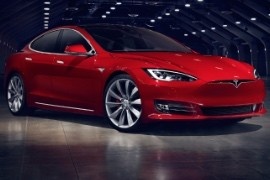
TESLA MOTORS Model S
Generations Timeline, Specs and Pictures

Customers always ask for more, and Tesla tried to offer them what they wanted, and even more.
That’s why the Model S received an update in 2016.
Tesla engineers knew that they could offer more for the Model S, but they didn’t want to provide it before it was tested. After that, other departments gathered and came up with new ideas. When all the parts were gathered, there was a one-man-only decision to make the changes: Elon Musk. And he gave the OK.
Most of the car remained the same, but with the new nose designed in the same line with the entry-level Model 3, it brought a new “brand-image” for Tesla cars. The flat area in the lower part of the bumper and the grille in the apron were redesigned.
Inside, the Model S didn’t look as luxurious as most of the other premium cars on the market. It still offered the biggest screen for the infotainment and command center on the center stack. The roomy interior provided enough room for five adults, with limited headroom for the rear passengers if a panoramic roof was installed. A pair of seats were available to be mounted in the trunk, converting it into a 7-seat vehicle.
The most significant update was the P90D version with Ludicrous mode. A warp-animation appeared on the center screen, and the car was ready to hit the 62 mph in just 2.8 seconds.

After the successful Roadster, Elon Musk understood that a four-door vehicle was needed on the electric car market.
A market that Tesla created.
The electric car revolution started when a sports car with an internal combustion engine lost a drag race in front of an anonymous car-manufacturer with a motor powered by a set of batteries. The introduction of the Model S made things look even worse for the sports-cars fans. The plastic-looking, silent vehicle challenged more and more supercars.
The world was not ready to see a car without a grille in the front, even though the Model S didn’t need one. So it featured a black plastic panel instead. The sharp, angular, headlights were fitted with LED in a time when the bi-xenon headlights have dominated the market. It was way ahead of its times. From the sides, the sleek and aerodynamic profile resembled a sports car’s look, but it featured four doors.
The interior was had a shocking look for its times. The minimalist design featured a dashboard dominated by a huge, portrait mode, 17” touch-screen placed over the center stack. It was fitted as standard with internet compatibility and over-the-air updates. The system controlled various car functions, including the charging, drive modes, and climate control unit. The car featured a panoramic glass roof. Due to the lack of a transmission tunnel, the flat floor allowed better legroom for the rear passengers, and the big wheelbase made the things even better.
Tesla installed a floor-mounted battery pack, consisting of laptop lithium-ion cells. Depending on the version, it powered the rear or all-wheels via two or four motors. The performances were stunning for its segment. The slowest version could reach 100 kph (62 mph) from standing still in 6.1 seconds, while the top model P90D did the same test in only 3 seconds.























































